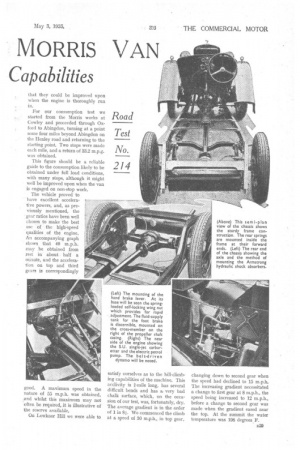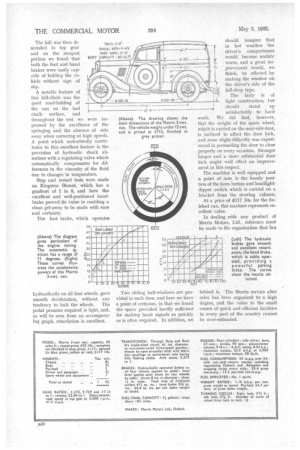THE SMALLEST
Page 42

Page 43

Page 44

If you've noticed an error in this article please click here to report it so we can fix it.
MORRIS VAN
Proves its
Capabilities
0 NE has come to expect a high standard of performance and reliability from any product of Morris Motors, Ltd„ and in these respects the 5-cwt. van, introduced last September, should prove to be capable of giving trouble-free service over long periods, with good. performance and economy of operating 'Costs.
" These observations are based on the results of a recent road test, when we gained the impression that, despite the small size and " highrevving" characteristics of the engine, there is evidence of an ample 'safety margin which should give long 'life to all parts subject to wear.
Throughout the chassis, which is of up-to-date design, there is evidence that the weight has been reduced to a minimum, but this reduction has not been gained at the expense of • adequate strength. Careful design has, however, enabled the complete vehicle to scale under 12 cwt. unladen, and it is, therefore, subject to a tax of but M.
The chassis is almost identical with that of the popular 8 h.p. car model, which is giving good service in the hands of many thousands of owners. We found the fully Lanen van to possess many of the characteristics which one usually associates with a high-grade private car.
The four-cylindered engine, which is of 918 c.c. capacity and is rated at 8.05 h.p., is equipped with a threebearing crankshaft of large diameter. This component is carefully balanced to-close limits, both statically and dynamically. The cylinders are cast integrally with the upper half of the crankcase which is extended well below the crankshaft centre to ensure maximum stiffness.
Light-alloy pistons are used and evidence of the care that is taken in production is shown by the fact that the piston and connecting-rod assemblies are equalized in weight to within .2 oz.
Of lightweight construction, the frame is amply braced by pressedsteel cross-members, the centre members being shaped to provide a tunnel for the propeller shaft. To minimize frame whip at the forward end the longitudinal members are boxed in, thus giving added. strength to this important section, • The engine and -gearbox unit is three-point Mounted on rubber, and the flexibility thus provided, together with the sturdy design and careful balance of the moving parts, gives a marked freedom from vibration throughout the speed range.
Three forward speeds and a reverse are provided by the gearbox, With a synchromesh mechanism for top and second gears. Gear changing proved to be delightfully simple and the silent second gear is really silent. The ratios have been well chosen and rapid changes, both up and down, may be made with the greatest of ease.
On taking over the van for our test, we found that the speedometer reading was but 50 miles. The engine was, therefore, on the tight Side, and although the figures we obtained for acceleration and petrol consumption are excellent, there is little doubt that they could be improved upon when the engine is thoroughly run in.
For our consumption test we started from the Morris works at Cowley and proceeded through Oxford to Abingdon, turning at a point some four miles beyond Abingdon on the Henley road and returning to the starting point. Two stops were made each mile, and a return of 33.2 m.p.g. was obtained.
This figure should be a reliable guide to the consumption likely to be obtained under full load conditions, with many stops, although it might well be improved upon when the van is engaged on non-stop work.
• The vehicle proved to have excellent accelerative powers, an& as previously mentioned, the gear ratios have been well chosen to make the best use of the high-speed qualifies of the engine. An accompanying graph shows that 40 m.p.h. may be obtained from rest in about half a minute, and the acceleration on top and third gears is correspondingly good. A maximum speed in the nature of 55 m.p.h. was obtained, and whilst this maximum may not often be required, it is illustrative of the reserve available.
On Lewlinor Hill we were able to
satisfy ourselves as to the hill-climbing capabilities of the machine. This acclivity is i-mile long, has several difficult bends and has a, very bad chalk surface, which, on the occasion of our test, was, fortunately, dry. The average gradient is in the order of 1 in 81. We commenced the climb at a speed of 30 m.p.h., in top gear, changing down to second gear when the speed had declined to 15 m.p.h. The increasing gradient necessitated a change to first gear at 8 m.p.h., the speed being increased to 12 m.p.h., before a change to second gear was made when the gradient eased near the top. At the summit the water temperature was 198 degrees F.
The hill was then de scended in top gear and on the steepest portion we found that both the foot and hand brakes were easily capable of holding the vehicle without sign of slip.
A notable feature of this hill-climb was the good road-holding of the van on the bad chalk surface, and throughout the test we were impressed by the excellence of the springing and the absence of side sway when cornering at high speeds. A point which undoubtedly contributes to this excellent feature is the provision of hydraulic shock absorbers with a regulating valve which automatically compensates for differences in the viscosity of the fluid due to changes in temperature.
Stop and restart tests were made on Kingston Blount, which has a gradient of 1 in 8, and here the excellent and well-positioned handbrake proved its value in enabling a clean get-away to be made with ease and certainty.
The foot brake, which operates hydraulically on all four wheels, gave smooth deceleration, without any tendency to lock the wheels. The pedal pressure required is light, and, as will be seen from an accompanying graph, retardation is excellent. Two sliding half-windows are provided in each door, and here we have a point of criticism, in that we found the space provided hardly sufficient for making hand signals as quickly as is often required. In addition, we should imagine that in hot weather the driver's compartment would become unduly
9 warm, and a great improvement would, we think, be effected by making the window on the driver's side of the full-drop type.
The body is of light construction, but should stand up satisfactorily to hard work. We did find, however, that the weight of the spare wheel, which is carried on the near-side door, is inclined to affect the door lock, and some slight difficulty was experienced in persuading the door to close properly on every occasion. Stronger hinges and 'a more substantial door lock might well effect an improvement in this respect.
The machine is well equipped and a point of note is the handy position of the horn button and headlightdipper switch which is carried on a bracket from the steering column.
At a price of 2117 10s. for the finished van, this machine represents excellent value.
In dealing with any product of Morris Motors, Ltd., reference must be made to the organization that lies
behind it. The Morris service after sales has been organized to' a high degree, and the value to the small owner of quick and efficient facilities in every part of the country cannot be over-estimated.




























































































